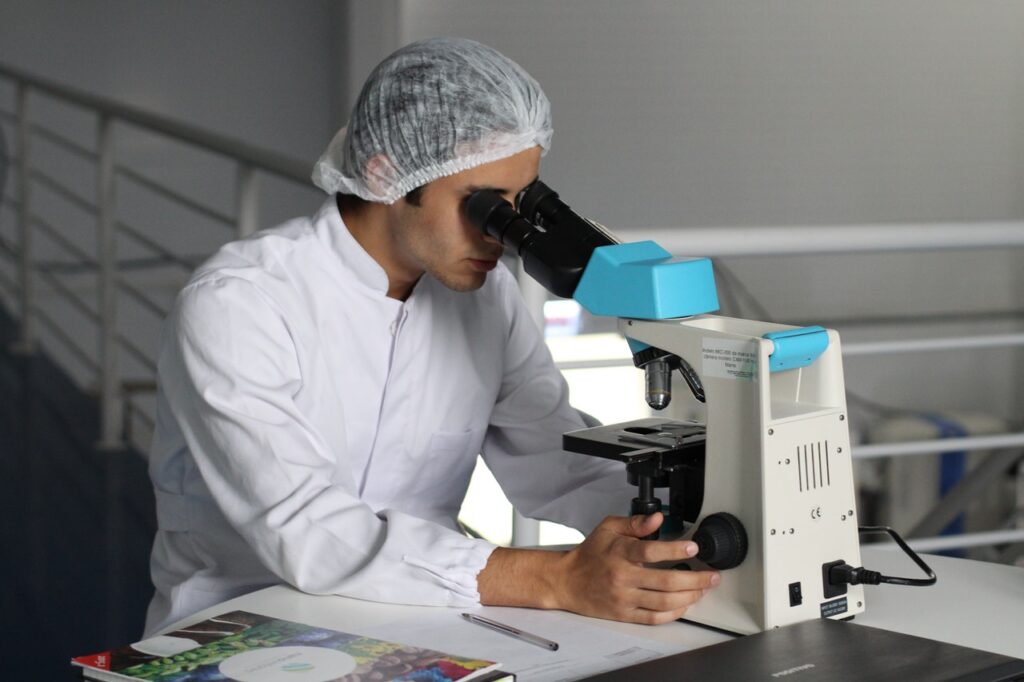What is Biomedical Engineering?
Biomedical engineering is the application of the principles and problem-solving techniques of engineering to medicine and biology. This is evident throughout healthcare, from diagnosis and analysis to treatment and recovery, and has entered the public consciousness through the proliferation of implantable medical devices, such as artificial hips and pacemakers, to more futuristic technologies such as the 3-D printing of biological organs and stem cell engineering.
There are many sub-disciplines within biomedical engineering, including the design and development of active and passive medical devices, medical imaging, orthopedic implants, biomedical signal processing, tissue and stem cell engineering, and clinical engineering, just to name a few.

Engineering itself is an innovative field, the origin of ideas leading to everything from automobiles to aerospace, sonar to skyscrapers. Biomedical engineering focuses on the advances that improve human health and health care at all levels.
Biomedical engineers differ from other engineering disciplines that have an influence on human health in that biomedical engineers apply and use an intimate knowledge of modern biological principles in their engineering design process. Aspects of mechanical engineering, chemical engineering, electrical engineering, materials science, mathematics, chemistry, and computer science and engineering are all integrated with human biology in biomedical engineering to improve human health, whether it be an advanced prosthetic limb or a breakthrough in identifying proteins within cells.
History of Biomedical Engineering
The practice of biomedical engineering has a long history. One of the earliest examples is a wood and leather prosthetic toe found on a 3,000-year-old Egyptian mummy. Before that, even walking sticks and simple crutches were a form of engineered assistive devices, and the first person to fashion a splint for a broken bone could be considered to have been an early biomedical engineer.
Biomedical engineering has evolved over the years in response to advancements in technology and science. Throughout history, humans have made increasingly more effective devices to diagnose and treat diseases and to rehabilitate, alleviate or compensate for disabilities or injuries. One example is the evolution of hearing aids to mitigate hearing loss through sound amplification. The ear trumpet, a large horn-shaped device that was held up to the ear, was the only “viable form” of hearing assistance until the mid-20th century, according to the Hearing Aid Museum.
The works of Thomas Edison and Alexander Graham Bell on sound transmission and amplification in the late 19th and early 20th centuries were applied to make the first tabletop hearing aids. These were followed by the first portable (or “luggable”) devices using vacuum-tube amplifiers powered by large batteries. However, the first wearable hearing aids had to await the development of the transistor by William Shockley and his team at Bell Laboratories. Subsequent development of micro-integrated circuits and advanced battery technology has led to miniature hearing aids that fit entirely within the ear canal.

There have been many other notable figures in the history of biomedical engineering, contributing to the development of various devices/methods that have improved the life of so many. Advancements have been made in artificial hip replacements, mechanical ventilators, artificial heart valves, and many more.
Biomedical Engineering Education
A biomedical engineering education is interdisciplinary because it combines biology and medicine with technology. The minimum job requirement is typically a bachelor’s degree in biomedical engineering, but some biomedical engineers have graduate degrees.
Bachelor’s degrees in biomedical engineering normally take four years of full-time study. Degree programs receive their accreditation from ABET, (Accreditation Board for Engineering and Technology). A typical BME program includes classes in chemistry, bio-materials science, engineering analysis, biomedical device engineering, calculus and physiology. Lab sections are also required, and many bachelor’s programs include practical experience in internships or co-ops with hospitals, for example. Although a biomedical engineering degree is preferred, some employers hire graduates of different engineering specialties and give them on-the-job training.

A master’s degree in biomedical engineering provides an alternate path to the career for graduates of other engineering disciplines. In addition, some master’s programs provide advanced training in a specialty to those with a bachelor’s in BME. At the University of Southern California, for example, full-time students can complete a general Master of Science in biomedical engineering in two years or less. However, the university also offers specialty master’s degrees for those who already have a bachelor’s in biomedical engineering. For example, students with a bachelor’s in BME can complete a master’s with specialization in neuroengineering in one year of full-time study.
Biomedical Engineering Careers
Jobs
Employment of biomedical engineers is projected to grow 7 percent from 2016 to 2026, about as fast as the average for all occupations, according to the BLS.
Biomedical engineers likely will see employment growth because of increasing possibilities brought by new technologies and increasing applications to medical devices and equipment. Smartphone technology and three-dimensional printing are examples of technology being applied to biomedical advances.
As the aging baby-boom generation lives longer and stays active, the demand for biomedical devices and procedures, such as hip and knee replacements, is expected to increase. In addition, as the public continues to become more aware of medical advances, increasing numbers of people will seek biomedical solutions to their health problems from their physicians.
Biomedical engineers work with scientists, other medical researchers, and manufacturers to address a wide range of injuries and physical disabilities. Their ability to work in different activities with workers from other fields is enlarging the range of applications for biomedical engineering products and services.
Salaries
An entry-level biomedical engineer with less than 1 year experience can expect to earn an average total compensation (includes tips, bonus, and overtime pay) of $61,628. An early career biomedical engineer with 1-4 years of experience earns an average total compensation of $65,747. A mid-career biomedical engineer with 5-9 years of experience earns an average total compensation of $79,648. An experienced biomedical engineer with 10-19 years of experience earns an average total compensation of $87,803 based. In their late career (20 years and higher), employees earn an average total compensation of $89,409, according to PayScale.com.
The top replies from companies for biomedical engineers are from Medtronic, Inc., The Food and Drug Administration and Boston Scientific Corporation. Reported salaries are highest at The Food and Drug Administration where the average pay is $86,566. Other companies that offer high salaries for this role include Becton, Dickinson and Company and Abbott Laboratories, earning around $82,000 and $80,497, respectively. 3D Systems, Incorporated pays the lowest at around $55,093. Stryker Corp. and Medtronic, Inc. also pay on the lower end of the scale, paying $70,873 and $72,107, respectively.
What do Biomedical Engineers Do?
Responsibilities
Job responsibilities of a biomedical engineer include:
- Design biomedical equipment and devices, such as artificial internal organs, replacements for body parts, and machines for diagnosing medical problems
- Evaluate the safety, efficiency, and effectiveness of biomedical equipment
- Install, adjust, maintain, repair, or provide technical support for biomedical equipment
- Prepare procedures, write technical reports, publish research papers, and make recommendations based on their research findings
- Present research findings to scientists, non scientist executives, clinicians, hospital management, engineers, other colleagues, and the public
- Research the engineering aspects of the biological systems of humans and animals with life scientists, chemists, and medical scientists
- Train clinicians and other personnel on the proper use of biomedical equipment

Skills
Biomedical engineering is the union of medicine and engineering. Professionals in this field are responsible for creating new devices, products and processes that advance the field of medicine. The possible career paths for biomedical engineers are numerous, from software development to research and development or manufacturing. Apart from technical skills, there are a number of different skills that are valuable for biomedical engineers to have:
- Careful measurement and analytical skills
- Creativity
- Curiosity
- Good attention to detail
- Interpersonal Skills
- Problem-solving
- The ability to empathise with patients
Future of Biomedical Engineering
Economically speaking, medical diagnostics triple in market value each year. Revolutionary advances in medical imaging and medical diagnostics are changing the way medicine is practiced. New medical devices, arising in the research laboratories of biomedical engineers around the world, have completely altered the manner by which disease and trauma is dealt with by physicians, extending the quality and length of human life.
The future of biomedical engineering is replete with opportunities for engineering professionals interested in enhancing human health, especially those willing to invest in knowledge of miniaturization and 3D printing.
Regardless of whether scientists want to tackle disease, create clothing that monitors body systems, or extend people’s quality of life into later years, making tech smaller and figuring out how to use a 3D printer for production will be a part of the journey. Miniaturization is a key development needed for wearable technology, as well as for delivering meds in vivo, designing sensors for brain-controlled prosthetics, and creating microneedles for drug-delivery systems. Three-dimensional printing likely will become integral to creating human organs and producing the intricate circuitry of temperature-controlled clothing.
Ultimately, the future of biomedical engineering is tied to both the issues and obstacles we discover and advances and achievements in fields like chemistry, materials science, and biology. Just as in most other fields, interdisciplinarity means that innovation originates from many directions at the same time.
If you have anything to add, please feel free to leave a comment down below, and sign up to our newsletter for more of the same content!




Thanks for talking about the skills needed for biomedical engineering. My cousin wants to find a biomedical college. I’ll share this info to give him some guidance about how to improve!